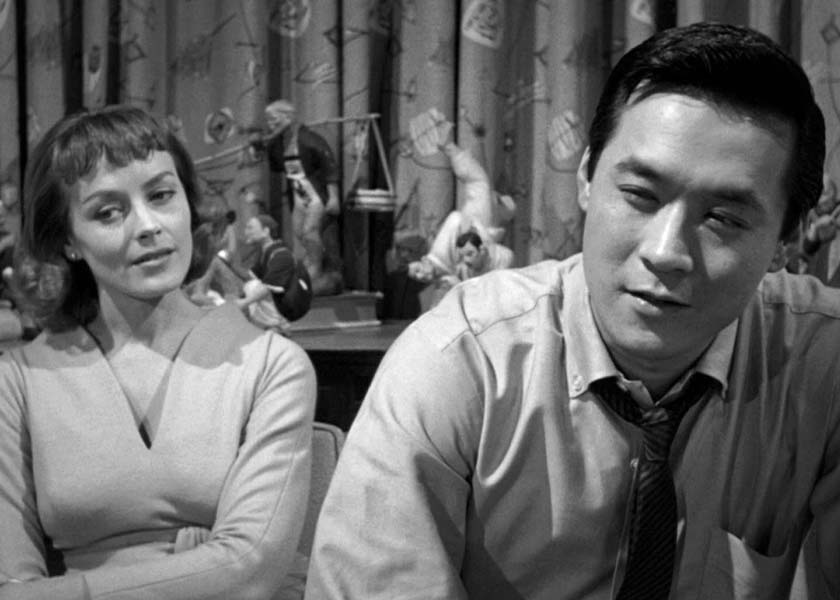Synopsis
In the Little Tokyo District of Los Angeles, California, a burlesque performer is chased down in the street and fatally shot. Detectives, and close friends, Charlie Bancroft (Corbett) and Joe Kojaku (Shigeta) investigate. The murdered dancer had been planning a new routine featuring a Japanese theme. Before killing the dancer, the murderer had put a bullet into a painting of the woman dressed in a crimson kimono. The picture had been painted by Christine Downs (Shaw), an art student. To aid the detectives Christine sketches Mr. Hansel, a man she saw at the dancer’s apartment.
After an attempt is made on Chris’s life, she moves in with the detectives for her protection. In no time, both men have fallen in love with her. She admits loving Joe. He, however, feels that his race stands between them. Joe becomes morose and distant and starts interpreting the actions of his friends as signs of racism. The estrangement becomes a quarrel, and Charlie and Joe have a violent interaction during a game of kendo.
The investigation continues, and they find Hansel (Neyle Morrow), the man in the sketch. An expert in Japanese art and culture, he was helping the dancer study Japanese culture for her act. Suddenly, Hansel’s lover appears, shoots at him, and flees. Joe chases her through the streets and shoots her. As the woman lays wounded, she confesses that she killed the dancer because she mistakenly thought her lover was having an affair with her. The murder was due to her misinterpretation of their actions.
This revelation makes Joe realize that he also has misinterpreted the words and actions of his loved ones, Charlie and Chris. He immediately reconciles with Charlie and kisses Chris.
Discussion
The Crimson Kimono starts as a murder mystery, but soon expands into a concurrent study of race relations, or, more accurately, a study of the perception of race relations from the point of view of an American of Japanese descent. Joe, conflicted about his love for a white woman and unsure of the reactions of his friends, misinterprets the words and actions of Charlie and Chris. Joe’s misperceptions cause him unhappiness, and, consequently, he mistreats his friends. The awful results of the murderer’s misperceptions awaken Joe to his own errors. This revelation allows him to break through the artificial racial barrier confounding his mind, and he immediately reunites with both his friend and his lover.
As the detectives investigate the murder, they move through a landscape of Japanese culture as found in the Little Tokyo neighborhood of Los Angeles. Little Tokyo provides a context for Joe’s examination of his racial inheritance and his relationship to the greater culture as represented by his friends.
In his autobiography, director Samuel Fuller states that the murder yarn bounced
around in his head for years. He planned an unconventional triangular love story.
According to Fuller, the head of Columbia Pictures, Sam Briskin, was concerned
about the response of average American audiences
to the love story and
wanted the white detective to be a louse so that the woman had a reason to prefer
the Japanese. However, Fuller’s idea was that both the men are good guys.
Christine just happens
to fall in love with one of them; race is irrelevant
to her choice. Fuller convinced Briskin to do the picture his way.
Before World War II, Hollywood mostly avoided the subject of mixed race romance. The few films that involved the subject would not end in the union of the couple unless one of them turned out to be a Caucasian after all. The closest a film could get to race mixing is a statement by the white person that the other’s race would not have been a barrier. The Crimson Kimono is a pioneering example that, by the late 1950s, it had become possible, despite some reservations among producers, for a film to depict the happy union of a racially mixed couple.

